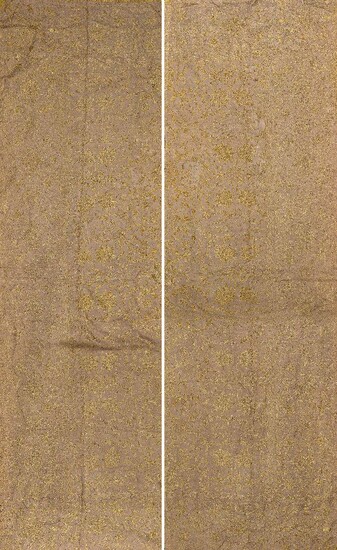An Indo-Portuguese Colcha (coverlet or quilt), Goa, India, first half 17th century, in two sections, cotton and Tussar silk, 94cm wide x 316cm. and 93.5 wide x 316cm.See Christie's Arts of India, June 12 2014, Lot 34 for the typeThe Portuguese were...
An Indo-Portuguese Colcha (coverlet or quilt), Goa, India, first half 17th century, in two sections, cotton and Tussar silk, 94cm wide x 316cm. and 93.5 wide x 316cm. See Christie's Arts of India, June 12 2014, Lot 34 for the type The Portuguese were the first to arrive in South Asia by sailing around Africa, capturing Goa in 1510. During the sixteen century, they were the leading European players in India and China. Spices and textiles were the most traded commodities at that time. During the peak times, about eight hundred thousand pieces of cloth were annually imported to Lisbon. In this context, the magnificently embroidered colchas changed from being exclusive diplomatic gifts or exotic souvenirs into marketable trade products that were meant to be sold to wealthy households. Using Chinese silk and local stitchwork, the colchas used Portuguese design elements. Colchas were made either in Goa or on the east coast in Bengal, and they are some of the earliest cross-cultural textiles known.
[ translate ]View it on
Estimate
Reserve
Time, Location
Auction House
An Indo-Portuguese Colcha (coverlet or quilt), Goa, India, first half 17th century, in two sections, cotton and Tussar silk, 94cm wide x 316cm. and 93.5 wide x 316cm. See Christie's Arts of India, June 12 2014, Lot 34 for the type The Portuguese were the first to arrive in South Asia by sailing around Africa, capturing Goa in 1510. During the sixteen century, they were the leading European players in India and China. Spices and textiles were the most traded commodities at that time. During the peak times, about eight hundred thousand pieces of cloth were annually imported to Lisbon. In this context, the magnificently embroidered colchas changed from being exclusive diplomatic gifts or exotic souvenirs into marketable trade products that were meant to be sold to wealthy households. Using Chinese silk and local stitchwork, the colchas used Portuguese design elements. Colchas were made either in Goa or on the east coast in Bengal, and they are some of the earliest cross-cultural textiles known.
[ translate ]


